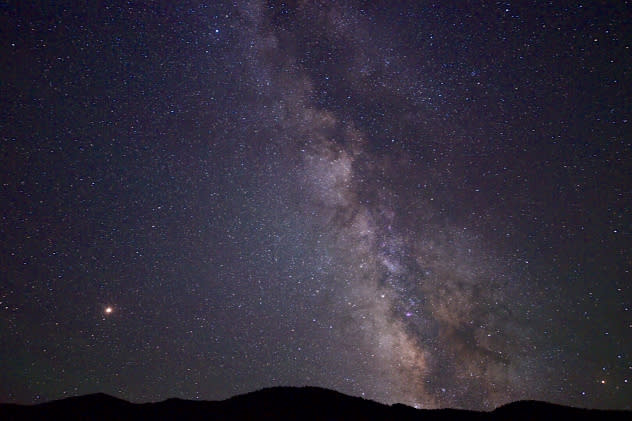Twin meteor showers, Thunder Moon to treat summer stargazers
In a month known for a frenzy of fireworks that can transform the night sky into a dazzling array of color, the cosmos will offer a few events of its own that will be visible around the world - no telescope required.
Despite July featuring some of the shortest nights of the year, it is an excellent time to enjoy the night sky without having to bundle up for cold weather. It is also one of the best months to see the Milky Way, which will be visible in the southern sky after nightfall, but only in areas far away from light pollution.
 |
The Milky Way in the light pollution-free sky over central Nevada. (AccuWeather/Brian Lada) |
The Milky Way is very dim to the human eye, so it is important to give your eyes at least 15 minutes to adjust to the dark to see it. The best nights to see the galaxy will be the nights surrounding the new moon, which will occur on July 9.
Stargazers can look for the Milky Way many times throughout the summer, but the top three astronomy happenings of July will only be visible on certain nights, so be sure to mark these events on your calendar:
1. Conjunction of Venus and Mars
When: July 12-13
The two planets closest to the Earth will appear extremely close in the evening sky around mid-July in an event known as a conjunction.
Venus has been putting on a show in the western sky in recent weeks and will continue to be a prominent post-sunset planet throughout July.
On Monday, July 12, Mars will appear close to Venus, although it will be much dimmer and harder to spot. A thin crescent moon will also be visible right after sunset above the duo.
 |
The two planets will appear close yet again on Tuesday, July 13, offering another opportunity to see the pairing for those who miss it the previous day. The moon will also be in the same area of the sky but will be a bit farther away from the planets when compared to July 12.
2. Thunder Moon, Saturn & Jupiter
When: July 23-24
Summer storms were the inspiration for the nickname of July's full moon, which will rise at sunset on Friday, July 23.
People outside this evening, and not experiencing a cloudy sky due to a thunderstorm, will be able to see the full Thunder Moon rise in the eastern sky and glow all night long.
Other nicknames for July's full moon include the Buck Moon, the Salmon Moon and the Raspberry Moon, The Old Farmer's Almanac said.
However, the Thunder Moon will not rise alone.
CLICK HERE FOR THE FREE ACCUWEATHER APP
As the night transpires, two planets will eventually rise above the horizon in the same area of the sky.
By midnight, Saturn and Jupiter will be visible just to the left of the moon, with the three appearing in a line across the southeastern sky.
 |
The moon will hang around the planets over the following nights, appearing between Saturn and Jupiter on the nights of July 24-25 and directly below Jupiter on the nights of July 25-26.
3. Double meteor shower
When: July 28-29
It has been nearly three months since the last moderate meteor shower sent shooting stars streaking throughout the sky, but that long stretch is about to come to an end with not one but two meteor showers peaking on the same night.
The most recent meteor shower was the Eta Aquarids in early May, but many skywatchers across the East Coast, northern Plains and Pacific Northwest missed out due to widespread clouds.
On the night of Wednesday, July 28, into the early morning of Thursday, July 29, the Southern Delta Aquarids and Alpha Capricornids will peak.
The two meteor showers will combine for around 15 to 20 meteors per hour, according to the American Meteor Society.
This equates to a shooting star every few minutes, but the intriguing part of the Alpha Capricornids "is the number of bright fireballs produced during its activity period." This means that some meteors could light up the entire sky as they burn up in Earth's atmosphere.
 |
A fireball photographed over the Atacama Large Millimeter/submillimeter Array in Chile. No changes were made to the image. (ESO/ C. Malin) |
These meteor showers will also be an appetizer for stargazers ahead of the Perseids in mid-August, one of the best meteor showers of the entire year.
Keep checking back on AccuWeather.com and stay tuned to the AccuWeather Network on DirecTV, Frontier, Spectrum, FuboTV, Philo, and Verizon Fios.







